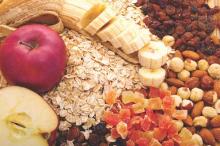Patients with remitted Crohn’s disease who avoided dietary fiber were significantly more likely to flare than were those who fell into the highest quartile of fiber consumption, according to a 6-month prospective study published in the August issue of Clinical Gastroenterology and Hepatology.
Avoiding fiber was not linked to flare in ulcerative colitis, however, said Carol Brotherton, MD, from George Mason University, Fairfax, Va., and her associates. “The results of this study support findings reported in investigations occurring in the 1980s: Low-fiber eating does not result in improved outcomes for individuals with Crohn’s disease,” they concluded. They recommended studies exploring why patients with Crohn’s disease restrict their fiber intake, and exactly how fiber-rich foods might benefit certain phenotypes of inflammatory bowel disease (IBD).
Studies have linked IBD to an abnormal mucosal response to gastrointestinal microbiota and have shown that dietary fiber affects the microbiome. But clinicians lack rigorous data to guide recommendations about fiber intake for patients with IBD, according to the investigators. “Although there are reasons to think that fiber could have a beneficial influence through generation of short-chain fatty acids, such as butyrate, patients with IBD are often instructed to limit their fiber consumption,” they noted (Clin Gastroenterol Hepatol. 2015 Dec 31. doi: 10.1016/j.cgh.2015.12.029).
To help clarify the issue, Dr. Brotherton and her associates analyzed 26-item dietary surveys for 1,619 adult participants in the Crohn’s and Colitis Foundation of America Partners Internet cohort. In all, 1,130 patients had Crohn’s disease, and 489 had ulcerative colitis or indeterminate colitis. All were in remission at baseline. Patients completed surveys then and again 6 months later. They ranged from less than 30 to more than 60 years of age, and half reported having had IBD for at least 11 years.
Patients with Crohn’s disease reported consuming a median of 14.6 grams of fiber per day (interquartile range, 11.6-18.6 g). Those in the highest quartile, who consumed a median of nearly 24 g/fiber a day, were significantly less likely to report having flared at 6-month follow-up than were patients in the lowest quartile of fiber intake, who consumed less than half that amount (adjusted odds ratio, 0.58; 95% confidence interval, 0.37-0.90). Patients with Crohn’s disease who reported not avoiding high-fiber foods also were significantly less likely to subsequently flare than those who said they avoided high-fiber foods (adjusted OR, 0.59; 95% CI, 0.43-0.81).
Patients with ulcerative colitis consumed, on average, 2 more grams of fiber per day than patients with Crohn’s disease, and fiber intake was not linked to flares in ulcerative colitis, the researchers said (aOR for highest vs. lowest quartile of fiber intake, 1.82; 95% CI, 0.92-3.60). Males reported consuming significantly more fiber than females (aOR, 4.7; 95% CI, 3.3-6.7 and aOR, 2.6; 95% CI, 1.9-3.6), while a history of hospitalization and surgery were linked to lower fiber intake, as reported by a study from the late 1970s (BMJ 1979 Sep;2:764-6).
“Despite the large size of the study, the numbers of participants in certain subgroups was limited,” the researchers acknowledged. “We do not have accurate information from this Internet survey about disease phenotype, particularly stricturing disease in Crohn’s disease. However, in sensitivity analyses among patients with Crohn’s disease, effect estimates were very similar after excluding those with any history of IBD surgery or hospitalization, suggesting that our observations of protective effects of fiber intake on flare were not influenced by aggressive phenotypes.”
The research was supported by the National Institutes of Health, the Patient-Centered Outcomes Research Institute, and the Crohn’s and Colitis Foundation of America. One coinvestigator reported ties to Salix, AbbVie, and NPS Pharmaceuticals, while the rest had no disclosures.


